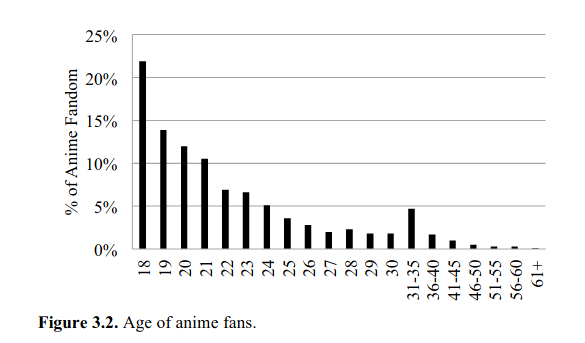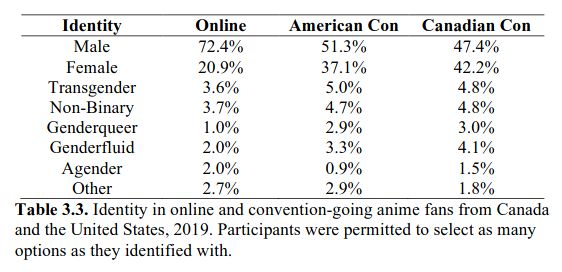The International Anime Research Project aims at studying anime, manga, and other fandoms. This team of scientists use techniques from psychology, anthropology, and sociology to understand the traits, demographics, and other attributes of anime fans. The team also compares different fandoms to understand the similarities and differences among the people within those fandoms. Most quotes and charts will be taken from their book, Transported to Another World: The Psychology of Anime Fans.
The team published the results of their work from 2013-2020. Their studies comprise of 14,125 participants taken from online sources and from various conventions. The participants are 18 years and up and are mostly from Western, English-speaking countries with most of the data coming from the US. The study examines genre preferences, political persuasion, demographics, and many other traits. The team compresses anime genres to 5 main categories: action, drama, slice of life, mecha, and hentai. The study also draws distinctions among anime fans, otaku, and cosplayers. Participants self-identify across their various identities and labels with multiple identifications allowed.
Some of the team’s data may surprise you! The data also reveals the general health and trends of the anime/manga fandom in the US. Let’s begin with some definitions. Fanship refers to an individuals connection with a thing, such as a sports team or anime. Fandom refers to an individual’s connection with a group that shares an interest in a thing:
Another way of saying this is that fanship is more similar to personal identity, while fandom is a collective identity from a social identity perspective. Indeed, studies show that there are plenty of people who wouldn’t call themselves sport fans (fanship) but who nevertheless enjoy the social connections they’ve formed while watching sports with other fans (fandom).
So, a study of the anime/manga fandom will include people who have less attachment to anime/manga and more attachment with the community surrounding those and other media. Fandom studies provide insight on the connection people have with each other through a certain fanship, when they have that fanship, and their expression of individuality within that fandom. The studies look into the patterns of people who enjoy the fandom.
Demographics of Anime Fans

Let’s begin with some demographics. Online anime fans different from fans who go to conventions. The 2019 study shows online anime fans average 24.9 years old with convention goers at 27.6 years old. Cosplayers skew young with an average age of 23.6 years. Remember, these data sets exclude underage anime fans. The average age of anime fans in general remains stable, which suggests the fandom grows by adding new fans as old ones leave the fandom. The fandom in general skews young. I’m definitely in the slivers of the older crowd! But why are convention goers older?
The team posits a few reasons:
- Cons are expensive; older fans may have more expendable income than younger fans.
- Older fans may be “bigger” fans and so go to conventions.
- Older fans may have more friends who go to conventions.
As fans get older, their interest in anime wanes with older fans reporting that they were bigger fans in the past. People age out of the fandom. However, among genre preferences, mecha fans stand out as the oldest of all fans.
The Western fandom is primarily White and Asian with a scattering of other ethnicities. When it comes to sexual identity and orientation, the fandom gets more complex:
- About 5.3% – 9% identify as transgender.
- About 5% identify as gay or lesbian.
- 88.2% of male anime fans identify as straight.
- 56.5% of female anime fans identify as straight.
- Anime fans are 4-8x more likely to identify as asexual versus 1% of Americans in general.
- Among otaku, 70% identify as male.
- Among cosplayers, 55.2% identify as female.
Depending on your outlook, the percentage of gay, lesbian, and transgender members of the fandom may seem low. Gallup (2022) finds 7.6% of US adults identify as something other than straight or heterosexual. The range found in the anime fandom study sits within the range Gallup uses.

The majority of online anime fans are single while the majority of con-goers are in a relationship of some type. This may be because online anime fans are a bit younger, and people wait longer to have relationships. Most fans are straight men and there are fewer available women in the fandom, which complicates finding someone who shares your interest. The team offers a bit of advice for single, online male anime fans:
What does that mean for the single, straight men in the online anime fandom who are looking for a partner? Our advice to them is to perhaps consider looking elsewhere for a partner with other shared interests and then introduce to anime or, if possible, make it out to more in-person events
(e.g., conventions, meet-ups) where you’re more likely to meet more women in the fandom!
Anime fans align with greater American society, where most of the samples originated, in Body Mass Index (BMI). Anime fans have an average BMI of 27.8, categorizing as overweight. American adults in general (71.7% of adults) categorize as overweight or obese. This datum shouldn’t be a surprise, but it also points to the stereotype of the fat anime-fan neckbeard isn’t true across the fandom. If you want to apply that stereotype, you’d have to apply it to the entire American population.
Consumption Habits
The consumption habits of anime fans breaks down into some interesting data points. Fan consumption serves 5 functions based on various studies beyond just this study:
- Display. Fans show off their allegiance to the fanship and fandom. Think team-branded merchandise.
- Knowledge Sharing. Merchandise acts as a conversation starter, allowing the fan a way to demonstrate her knowledge and recruit new fans.
- Ritual Activity. Regular use and consumption of a fanship creates a sense of order and predictability. Think about people who religiously watch football games on the weekends.
- Collection. Fans enjoy the act of finding and securing valued or important fan-objects. Think about people who collect signed jerseys or video game cover variants.
- Devotion. The costs to collect merchandise or participate in the fandom shows sacrifice and dedication to the interest. Wearing merchandise can lead to bullying or other ways to “suffer” for a fan identity.
Otaku (primarily male) and cosplayers (primarily female) stand as the subgroups that consume the most manga/anime merchandise, official and fan-created. Otaku are more likely to identify as cosplayers and as weeaboo. Otaku and cosplayers watch anime, read manga, read about anime, and talk to friends at anime more often than non-otaku. They listen to J-pop and anime soundtracks; they read visual novels, light novels, doujinshi, and play more anime-themed games. Cosplayers are more likely to speak about their anime interest than non-cosplayers. They also report a greater sense of well-being than non-cosplayers, perhaps because they have more friends and face-to-face relationships with the fandom. Female cosplayers are more likely to crossplay, cosplay as a character with a different gender, than males: 43.1% vs 13%.
As a group, cosplayers tend to be young, working women who were more likely than non-cosplayers to be in relationships and to be writers and artists. Cosplayers are, all-around more active and involved when it comes to anime, watching more, spending more money on it, and attending more conventions.
Watching habits of anime fans varies a bit across the different surveys. Data is always subject to caveats, so everything I’ve shared from this report, as with any study, needs to retain an asterisk beside it. I write in absolutes just for simplicity. There’s always overlap in data sets. With that reminder out of the way:
- Fans prefer subtitles (49.5%) over dubs (10%), but 40.4% of fans don’t have a preference.
- Among action anime fans, dubs are preferred.
- 63.29% of fans watch through unofficial streaming services.
- 56.28% of fans watch through paid streaming services.
- 40.25% of fans watch through unofficial downloads.
- 21.56% of fans buy media.
- 16.13% of fans wait for television releases.
- 61.4% of fans consume fan-made anime content.
As anime fans age, they watch fewer new titles while younger fans are more likely to watch newer titles and less likely to watch older anime. As the team writes: “It seems anime fans prefer to watch the series that were popular when they were growing up, a trend mirrored in other fandoms.”
Fans of certain genres tend to stigmatize fans of other genres; think action fans versus slice of life fans. Mecha fans, the oldest genre demographic, are the only ones who have a fan identity that doesn’t hold feelings of hostility toward other fandoms or types of anime fans. They also don’t perceive stigma toward themselves or other anime fans for their genre preferences. But they have more feelings of superiority, likely because of their time spent in the fandom. Other than mecha, fans of the other genres use their consumption habits to define themselves, at least in part, in opposition to other fans.
Fans of hentai consume more anime in general than fans of the other genres. They buy more merchandise and tend to gatekeep against new fans. Anime fans (34.3%) rate hentai as “at least somewhat favorable” and “something they are a fan of” with 4.3% rating hentai as their favorite genre. Men are more likely to watch hentai, and hentai fans are interested in anime because of their significant sexual attraction to the content. Hentai fans are a bit more likely to be in a relationship. Hentai fans score highest in measures of sexism but also score lower on prejudice toward LGBTQ+ people. In other words, fans of hentai are complicated.
My Thoughts
The data from this series of studies surprised me in a few ways. I hadn’t expected the majority of cosplayers to be women, nor did I expect convention goers to be more likely to be in a relationship. The data pointing toward the anime fandom as mostly male doesn’t surprise me. Men tend to consume more media and seek belonging among a larger “tribal” group than women. The data also points toward how women tend to identify in a more gender-fluid manner than men, which ties into research from evolutionary psychology. Anime fans are normal people. Their demographics align with the demographics of wider America. When you read through the book, the normalcy stands out. Otaku, cosplayers, and anime fans in general aren’t as stereotyped. While they are mostly male and single, the relationship distribution aligns with male singleness in the greater population. Young men are, by and large, likely to be single. Older men (and women) have increasing likelihood in being in a relationship. The research suggests the anime we receive in the US targets men more than women. There’s nothing wrong with media targeting one demographic more than another. Romance novels target women, and few have problems with that. But the fandom would benefit from achieving a more equitable split and more ethnic diversity. Of course, as with all studies, many participants may not have revealed their real ethnicity. A better balance would encourage companies to release a greater variety of stories to the US.
Being a part of a fandom like anime/manga links to a greater sense of well-being. You find a place you feel you belong, enable you to make friends and share interests. Conventions provide a means for face-to-face relationships, which are needed with our digital disconnect. Convention costs seem to pose a problem for many fans. Reducing these by reducing the scale of conventions and by having more local conventions would help remedy this. Conventions typically appear in major cities. Perhaps these conventions could offer smaller, more rural-oriented conventions. Balancing profit may prove problematic with this, but these smaller conventions could be subsidized by the larger conventions and act as a funnel to pull more fans into the larger conventions.
The fact mecha fans tend to be older and more accepting, if more elitist, of new fans and fans of different genres surprised me at first. But mecha favors complex political stories that explore moral ambiguity. It’s also one of the few genres that has older characters as the norm. This and the data’s suggestion that anime fans age out points to how American anime needs more mature, not high school, stories. Older fans have more disposable income and often have children. The anime industry would benefit by trying to retain these fans. The industry would tap into a higher income source that can “proselytize” their children into the fandom. In other words, the manga/anime industry leaves money on the table with how it fails to retain older fans.
I recommend you read through the study. It is long, but the team offers it for free as thanks to the community. The study delves into comparisons among the anime fandom, furry community, and Brony community. The comparisons offer insights into each community. There’s a lot more data in the study than I cover here. You will also learn about how research structure and sampling shapes research results. The team discusses limitations and problems with their research methods. If you aren’t familiar with research like this, the book offers good explanations. Here’s the International Anime Research Project’s website again if you want to snatch the book or participate in their future research.
References
Gallup (2022)What Percentage of Americans Are LGBTQ+? https://news.gallup.com/poll/332522/percentage-americans-lgbt.aspx.
Reysen, Stephen, Plante, Courtney, Chadborn, Daniel, Roberts, Sharon, Gerbasi, Kathleen (2021) Transported to Another World: The Psychology of Anime Fans. International Anime Research Project. Commerce Texas.







Oh yeah, a lot of cosplayers are usually female. I know people in the scene from my interactions from the community.
Also, conventions tend to be expensive as hell. It would be nice to have more local ones. I do worry about a potential convention bubble happening in the States at some point.
And regarding older anime fans with families of their own, I feel that most of them still prefer the mainstream stuff that’s relevant, so they can talk to their kids about them.
I’ve grown out of most anime and mostly read manga, which doesn’t get enough attention despite manga being everywhere now.
It is curious how manga doesn’t receive more attention. Even in “Library Land” despite all the talk of manga as an outreach tool for teens, manga still doesn’t get the same level of spending as other mediums. I’m attempting to get more into manga. I find the text sometimes difficult to read with my poor eyesight, and I still prefer physical books over electronic. I need to get over that preference.
Looking at the stats, I was also thinking they looked rather like a typical cross-section of the general population. And when you make the comparison to organized sports, it makes sense. Both involve the consumption and knowledge of easily accessible stories, creating social groups based around the experience. That cosplayers tend to be younger also doesn’t surprise me. A fifty-something Motoko Kusanagi, Faye Valentine or Ryuko Matoi just loses something in the translation.
In Japan, hentai used to be more visible. It wasn’t uncommon to see it openly read on trains… not so much anymore. “Hentai fans are a bit more likely to be in a relationship.” Makes sense to me. To quote (allegedly) Alfred Adler, “The only ‘normal’ people are the ones you don’t know very well.”
The research helps show how anime fans, and other fandoms, aren’t deviant or “weird.” At least, no weirder than anyone else (great quote, even if it doesn’t belong to Adler!). Research like this needs to have more exposure to help dissipate some of the large-brush strokes smearing the anime/manga fandom.
You make a good point about cosplayers not able to represent certain characters as accurately as they age. Although, they could represent a few of the older ones or have fun with showing “aged” characters. Think of Faye with a walker! 😀
Oh totally, Chris. It would be Old Faye visiting her friends at the old folks home